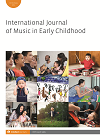
Full text loading...

Guided by children’s right as active citizens to be heard and have their views taken into account on matters affecting their lives, this article explores opportunities early childhood music educators can provide for children’s voices to inform their practices. Drawing on experiences from the Children’s Voices project, the author describes ten key principles that guide authentic dialogic encounters with children. Connections are made to research in early childhood music throughout the article. These connections inform how music in its various guises can be used as a medium for engaging with children’s voices and, conversely, how children’s voices can and should inform early childhood music education.

Article metrics loading...

Full text loading...
References


Publication Date:
https://doi.org/10.1386/ijmec_00055_1 Published content will be available immediately after check-out or when it is released in case of a pre-order. Please make sure to be logged in to see all available purchase options.